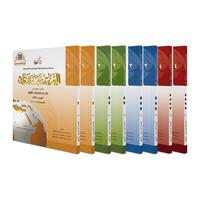٣،٤،٢٥ - السنة النبوية - كتابة حديث المصطفى ﷺ
3,4,25 – Sunnah des Propheten – Schreiben des Hadith des Auserwählten, Friede und Segen seien auf ihm
3,4,25 - The Sunnah of the Prophet - Writing the Hadith of the Mustafa, peace be upon him
3,4,25 - Sunnah del Profeta - Escribiendo el hadiz del Elegido, paz y bendiciones sean con él
3,4,25 - Sunna du Prophète - Écrire le hadith de l'Élu, paix et bénédictions soient sur lui
3,4,25 - La Sunnah del Profeta - Scrivendo l'Hadith del Prescelto, la pace sia su di lui
3,4,25 - Sunnah van de Profeet - Schrijven van de hadith van de Uitverkorene, vrede en zegeningen zij met hem
3,4,25 - Profetens Sunnah - Skriver den Utvaldes hadith, frid och välsignelser över honom
3,4,25 - Peygamber'in Sünneti - Seçilmiş Kişi'nin hadislerini yazmak, barış ve bereket onun üzerine olsun
وردت عن النبي - ﷺ نصوص تأذن بكتابة الحديث، ونصوص أخرى تمنع كتابة الحديث.
Es gab Texte des Propheten – Gottes Gebete und Friede seien auf ihm –, die das Schreiben von Hadithen erlaubten, und andere Texte, die das Schreiben von Hadithen verbot.
There were texts from the Prophet - peace be upon him - that permit the writing of hadiths, and other texts that prohibit the writing of hadiths.
ومن النصوص التي تأذن بالكتابة قوله - ﷺ - لعبد الله بن عمرو بن العاص: (اكتب فوالذي نفسي بيده ما خرج مني إلا حق) ومن النصوص التي تنهى عن الكتابة قوله - ﷺ - (لا تكتبوا عني، ومن كتب عني غير القرآن فليمحه).
Among the texts that permit writing is his saying - peace and blessings of God be upon him - to Abdullah bin Amr bin Al-Aas: (Write, for by the One in whose hand is my soul, nothing has come out of me except the truth.) And among the texts that forbid writing is his saying - peace and blessings be upon him - (Do not write on my behalf, and whoever writes on my behalf other than the Qur’an, let him erase it).
وقف العلماء بين الأمرين: الإذن بالكتابة، ومنع الكتابة، فقالوا : إن المنهي عنه كتابة الحديث مع القرآن في كتاب واحد ، خوف الخلط بينهما .
The scholars decided between the two matters: permission to write, and prohibition of writing. They said: It is forbidden to write the hadith and the Qur’an in one book, for fear of mixing them together.
فإذا لم يخش الخلط فلا مانع من كتابة الحديث.
Wenn keine Angst vor Verwirrung besteht, gibt es keine Einwände gegen das Schreiben des Hadith.
If there is no fear of confusion, then there is no objection to writing the hadith.
ويؤيد هذا أن بعض الصحابة كتبوا كثيرا من الأحاديث في الصحف، وقد كان ما كتبوه الأساس لتدوين الحديث فيما بعد .
Dies wird durch die Tatsache gestützt, dass einige der Gefährten viele Hadithe in Zeitungen verfassten und dass das, was sie schrieben, die Grundlage für die spätere Kodifizierung der Hadithe bildete.
This is supported by the fact that some of the Companions wrote many hadiths in newspapers, and what they wrote was the basis for codifying the hadith later on.
في خلافة عمر بن عبد العزيز - رحمه الله - طلب من والي المدينة، ومن ولاة آخرين كتابة الحديث؛ خوفا من ذهاب الحديث بموت الصحابة .
During the caliphate of Omar bin Abdul Aziz - may God have mercy on him - he asked the governor of Medina and other governors to write down the hadith. For fear that the hadith would disappear with the death of the Companions.
وكانت هذه أول حركة منطمة، لكتابة الحديث الشريف.
This was the first organized movement, to write the honorable hadith.
وفي القرن الثالث الهجري، ظهرت كتب الأحاديث السنة، وهي : صحيح البخاري، وصحيح مسلم، وسنن أبي داود ، وسنن الترمذي، وسنن النسائي، وسنن ابن ماجة .
In the third century AH, books of Sunnah hadiths appeared, namely: Sahih Al-Bukhari, Sahih Muslim, Sunan Abu Dawud, Sunan Al-Tirmidhi, Sunan Al-Nasa’i, and Sunan Ibn Majah.
وقد أضيف إليها : موطأ الإمام مالك، ومسند الإمام أحمد، وسنن الدارمي.
Es wurden hinzugefügt: das Muwatta von Imam Malik, das Musnad von Imam Ahmad und Sunan al-Darimi.
To it have been added: Muwatta of Imam Malik, Musnad of Imam Ahmad, and Sunan al-Darimi.
وقد عرفت هذه الكتب بالكتب النسعة، وهي مقدمة على غيرها من كتب الحديث، وقد اعتمد عليها علماء الشريعة في معرفة العقائد والأحكام.
Diese Bücher waren als Al-Nasa'a-Bücher bekannt und werden mit anderen Hadith-Büchern verglichen, und Scharia-Gelehrte verließen sich auf sie, um die Überzeugungen und Regeln zu kennen.
These books have been known as the Nass’ books, and they take precedence over other books of hadith, and Sharia scholars have relied on them to know the beliefs and rulings.

